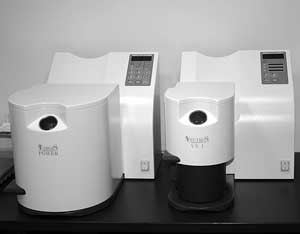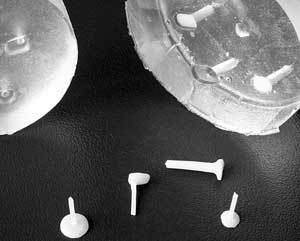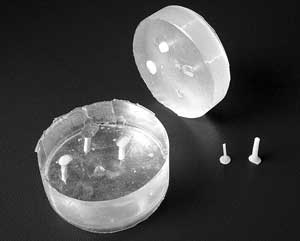

|
Journal Home Contents Preview Next |
Pro Otology
Balkan Journal of Otology & Neuro-Otology, Vol. 3, No 2—3:106—108 © 2003
All rights reserved. Published by Pro Otology Association
Technological Setting for Production of Ossicular Prostheses Made of High-Technology Material “Targis”
M. Milkov, K. Fiolkovski, R. Gabrovski
Clinic of Otorhinolaryngology, Medical Faculty, Varna, Bulgaria
ABSTRACT
Hypothesis: The proposed by us prosthesis for ossicular reconstruction made of ceramic optimized polymer – Targis is new in otology. The aim of this article is to acquaint otosurgeons with the fundamental scheme of preparation of prostheses.
Background: In order to receive the final form and size of the prostheses we need: Targis (ceromer material), silicon matrix, applicators, which are used to fill the matrix with Targis and high-technology polymerization apparatus – Targis Power and Targis Quick.
Methods: First we determined the most frequently used sizes of ossicular prostheses. Then we created the silicon matrix, which was filled with Targis using a special applicator. The next step was curing of the prostheses and polishing.
Results: The prepared prostheses were analyzed. Pores and cracks were not found . The links between the different parts of the prostheses were stable. The material allows changes of prosthesis length by cutting, which does not disturb the integrity of the prosthesis.
Discussion: In our trial we used a completely new for the otology material – Targis. However, it is widely and successfully used in dentistry for dental prostheses for years. The technology for preparing the prostheses is simple and safe. Our trials showed that the very low percentage of defects in the prostheses is due to the additional polishing procedures. Using the high-technology polymerization apparatus – Targis Power, which is suitable for this material, we achieved higher quality and safety. The programs of the apparatus are fixed, but we have the possibility for individual optimization.
Key words: Ossicular prostheses, Biocompatibility, Biomaterials, Targis.
Pro Otology 2-3: 106-107, 2003
Introduction
What is the best biomaterial and what is the best prosthesis? The question, which will concern generations of bioengineers, histologists, physicians and biophysicists years on end. Even being ideal as for compatibility in the organism, a biomaterial can be neglected if the prosthesis, made of it, does not fulfill the lost or affected physiological function, which has to be recovered (1).
In our studies we found out an exceptional variety of types of biomaterials and forms of prostheses for ossiculoplasty. At our consultations with famous otosurgeons in Bulgaria and abroad, we were encouraged that as long as we have found such a good for the otology biomaterial as for biocompatiblity, we are under an obligation to create an optimized form of prostheses and an effective and efficient scheme of production.
Aim and tasks
To create prosthesis with form, size and weight, suitable for implantation in hearing – improvement operations.

|

|
|
FIG 1. Polymerization apparatus - Targis Power. |
|
Material and methods
We used a high – technology polymerization apparatus - Targis Power. It combines the factors light and heat. Eight cold light flows create the power of the polymerization process. Besides we also used Targis – Quick with a precisely centered light ray, leading to segmental polymerization. A silicone matrix and applicators, which it was filled with.
Stages of creation of prostheses:
1. Particularization of length, size and form of the prosthesis.
2. Creation of a prototype of the prosthesis – it is made of laboratory materials of real size.
3. Construction of a matrix. Requirements (transparence, plasticity, elasticity, heat – resistance).
An additive silicone occurred to be the most suitable material because of its advantages.
“Targis” is a photo - polymerizing material and this is the reason why the matrix should let light through.
The prostheses have an exactly determined diameter and are made with a possibility to change length.
They have the advantage to be quite fine, stable in case of high tensions, but at the same time they have an asymmetric retention form and this is the reason why the matrix should be elastic. Thus no damage of the ready polymerized prostheses is allowed.
4. Squirting of material. “Targis” is dough-like material, packed in special photo-isolated capsules, which are squirted in a matrix.
5. Firing in Targis – Power polymerizing furnace. The matrix with the prostheses is placed in this furnace at the temperature of 95°C for 25 minutes.
6. Drawing out of prostheses.
7. Correction of dimensions.
8. Finery with rotation tools.
9. Measurement of weight of prostheses.
10. Sterilization.

|

|
|
FIG 2. Drawing out of prostheses. |
|
Discussion
In the scheme, offered by us, we look for consistency and precision in the preparation of the prosthesis. An exactly determined model can be offered and prepared depending on the specific defect of the ossicular chain. The prostheses can be fixed to the preserved part of the ossicular chain with the help of photo - polymeric cement – Vario Link of IVOCLAR Company by a photo-polymerizing lamp (2-8).
Conclusions
1. The advantage to create prostheses of different form;
2. Easy achievement of the desired weight;
3. The prostheses, prepared through this scheme, have good physical characteristics;
4. Possibility for a stable fixing of the prosthesis to the ossicular chain and reduction of the risk of extrusions;
5. Effectiveness of the technological scheme.
REFERENCES
Alander PM, Lassilia LV, Tezvergil A, Vallittu PK. Akoustic emission analysis of fiber–reinforced composite. Journal of Dental Research (Spes Iss A) 2002;81.
Kistler S, Frasch C, Pospiech P. Clinikal performance of multjunit Targis/Vektris fiber–rerinforsed bridges :one year results. JDR 2001;80:59.
Febbrari M, Baldissara P, Arcidiano A. Fracture resistance of Targis – Vektris. FPD 2001;80:758.
Cho LR, Song Hy. Marginal accuracy and fracture strendth of Targis/Vektris with different preparation. JDR 2001;80: 656
Saravia MA, Cacers P, Powers JM. Superficial hardness of a new ceromer (Targis) using different common beverage and solution. JRD 2000;79:248
Groger G, Rosentritt M, Behr M, et al. In vitro bacterial adhesion onto facing materials. JRD 2000;79:350.
Peng CC, Lu WC, Lin FH, et al.. The flehural strength of Targis / Vektris system with /without Targis Base. JDR 1999;78:156.
Knox E, Lindquist TJ. In vitro microleakage of Targis – Vektris crowns after cyclic loading. JDR 1999;78:301.
|
Pro Otology |
Journal Home Contents Preview Next |